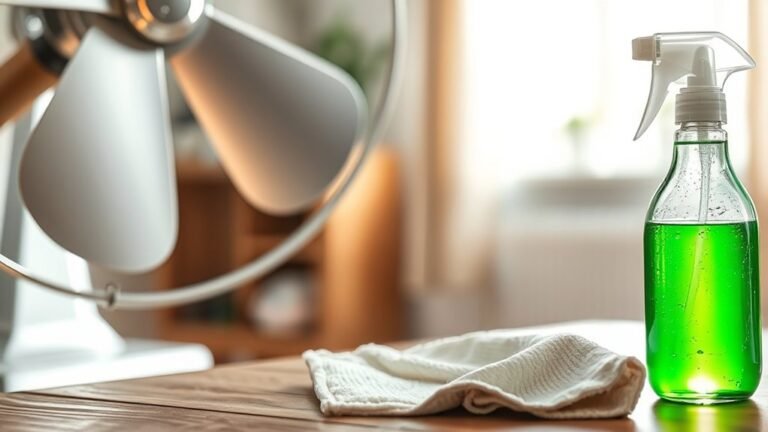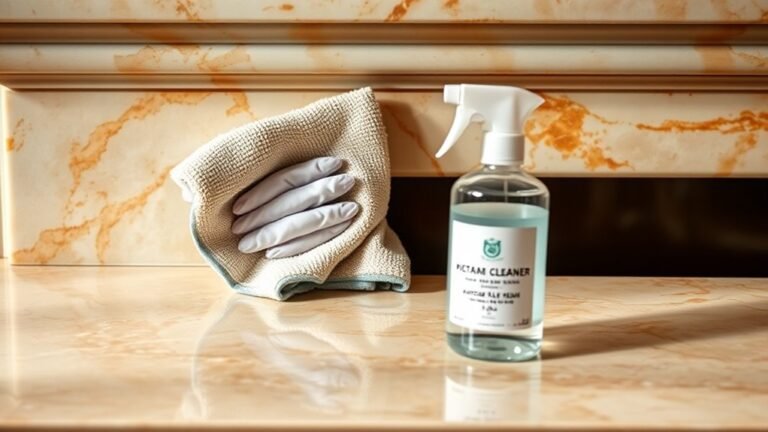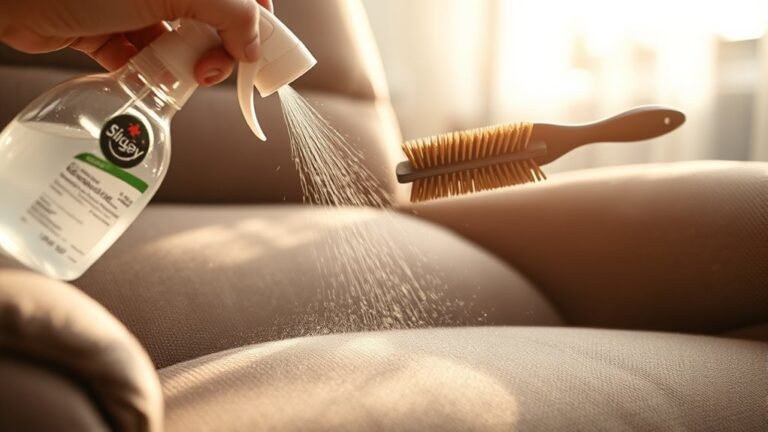Budget-Friendly DIY Cleaning Products for Ceilings
You can easily clean your ceilings on a budget using DIY products made from household staples like vinegar, baking soda, and hydrogen peroxide. Vinegar mixed with water creates a natural disinfectant, while baking soda forms a gentle paste for stains. Hydrogen peroxide diluted with water effectively removes mold without harsh chemicals. These ingredients are safe, eco-friendly, and cost-effective, giving you control over what you use. Keep going to discover more tips for cleaning and maintaining your ceilings efficiently.
Benefits of Using DIY Cleaning Products for Ceilings

While professional cleaners can be effective, using DIY cleaning products for your ceilings offers several advantages. You gain significant cost savings by avoiding expensive services and commercial products. Plus, you control exactly what goes into your cleaning solutions, reducing harmful chemicals that can impact your health and the environment. This freedom lets you choose eco-friendly ingredients that minimize environmental impact, helping you maintain a cleaner home without compromising your values. DIY methods give you flexibility, allowing you to tailor your cleaning routine to your schedule and preferences. Embracing these simple, budget-friendly options means you’re not only saving money but also contributing to a greener planet—all while enjoying the independence of handling your ceiling cleaning on your own terms.
Essential Household Ingredients for Ceiling Cleaning
Three simple household ingredients can make a big difference when cleaning your ceilings: baking soda, white vinegar, and mild dish soap. These essentials give you the freedom to tackle grime without harsh chemicals.
- Baking Soda: A gentle abrasive, it lifts dirt and stains while deodorizing your ceiling surface.
- Household Vinegar: This natural disinfectant cuts through grease and mildew, leaving your ceilings fresh.
- Mild Dish Soap: It breaks down grime effectively without damaging paint or texture.
With these ingredients, you’re equipped to create powerful, budget-friendly cleaners. They’re easy to find, safe, and let you maintain your ceilings on your own terms. Embrace the simplicity and control you get from using household staples for a spotless ceiling.
How to Prepare a Vinegar-Based Ceiling Cleaner

Mixing a vinegar-based cleaner for your ceiling is straightforward and requires just a few common ingredients. Start with white vinegar, known for its natural acidity and powerful vinegar properties that break down dirt and grime effectively. Combine one part vinegar with three parts warm water in a spray bottle. For added cleaning efficiency, you can add a few drops of your favorite essential oil to mask the vinegar scent if you like. Give the bottle a good shake to mix everything well. When you’re ready, spray your solution lightly onto the ceiling and wipe gently with a microfiber cloth or sponge. This DIY cleaner lets you maintain your ceilings without harsh chemicals, giving you freedom to clean safely and efficiently on your own terms.
Making a Baking Soda Paste for Stubborn Ceiling Stains
To tackle stubborn ceiling stains, you’ll need just a few simple ingredients to make a baking soda paste. Applying it carefully with the right technique can help lift even tough spots without damaging your ceiling. I’ll also share some handy tips to make sure those stains come off cleanly and easily.
Ingredients Needed
A simple baking soda paste can tackle stubborn ceiling stains effectively. You’ll appreciate how natural ingredients not only keep your home safe but also provide cost savings compared to commercial cleaners. To whip up this powerful paste, you only need three basic items:
- Baking Soda – Acts as a gentle abrasive to lift stains without damaging your ceiling.
- Water – Just enough to create a spreadable paste consistency.
- White Vinegar (optional) – Enhances stain removal with natural acidity if needed.
Using these straightforward ingredients gives you the freedom to clean efficiently and affordably. No harsh chemicals, no pricey products—just nature’s simplest tools to refresh your ceilings and maintain a healthy space.
Application Technique
Getting the baking soda paste just right is key for tackling stubborn ceiling stains effectively. You want a consistency thick enough to stick but spreadable enough to cover large areas. Mix baking soda with a bit of water gradually, adjusting as needed. Remember, your ceiling height will influence how you apply the paste—using the right cleaning tools like an extendable brush or sponge can make the job easier and safer.
| Ingredient | Quantity | Purpose |
|---|---|---|
| Baking Soda | 1 cup | Cleaning agent |
| Water | 1/4 – 1/2 cup | Adjust paste texture |
| Optional: Vinegar | 1 tbsp | Boost stain removal |
Use a ladder or pole extender to reach high spots, ensuring even coverage without strain or risk.
Stain Removal Tips
One simple yet effective method for stubborn ceiling stains is using a baking soda paste. It’s versatile enough to tackle various stain types, giving you the freedom to clean without harsh chemicals. Here’s how you can make and apply it:
- Mix 3 parts baking soda with 1 part water to form a thick paste.
- Apply the paste directly to the stained area, focusing on spots that regular cleaning can’t remove.
- Let it sit for 15-20 minutes, then gently scrub with a soft brush and rinse with a damp cloth.
Adjust your cleaning frequency based on stain severity to prevent buildup. This DIY approach empowers you to maintain your ceilings efficiently while staying eco-friendly and cost-effective.
Using Lemon Juice as a Natural Ceiling Brightener
You’ll love using lemon juice to naturally brighten your ceiling since it’s gentle and effective. Just mix it with water and apply it carefully to avoid over-saturation. Remember to test a small area first and wipe off any excess to prevent damage.
Benefits of Lemon Juice
Although lemon juice is often associated with cooking and skincare, it’s also a powerful natural cleaner that can brighten your ceilings effectively. When you use lemon juice, you’re not only tapping into a natural disinfectant but also embracing a chemical-free way to refresh your space. Here are three key benefits:
- Brightening Power: Lemon juice’s natural acidity helps break down stains and yellowness on ceilings, restoring their original glow.
- Antibacterial Properties: Acting as a natural disinfectant, it reduces germs and mold without harsh chemicals.
- Eco-Friendly and Safe: You avoid toxic residues, making it a safer choice for your home and the environment.
Choosing lemon juice means you’re taking control with a budget-friendly, effective, and liberating cleaning option.
Application Tips for Ceilings
Lemon juice’s natural acidity makes it an ideal choice for brightening ceilings, but applying it correctly guarantees the best results without damage. When tackling your ceiling, consider its height and your cleaning frequency to avoid overuse or missed spots. Use a spray bottle for even application, and test a small area first. Here’s a quick guide:
| Step | Tip |
|---|---|
| Prepare Solution | Mix lemon juice with water (1:2) |
| Application Tool | Use a microfiber cloth or sponge |
| Ceiling Height | Use an extension pole if high |
| Cleaning Frequency | Brighten every 3-6 months |
| Drying | Let air dry, avoid wiping off |
This approach frees you from harsh chemicals while keeping ceilings fresh and bright.
Crafting a Mild Soap Solution for Regular Ceiling Dusting

Creating a mild soap solution is one of the simplest ways to keep your ceilings free from dust without causing damage. This approach leverages mild soap benefits, allowing you to maintain a clean ceiling surface while preserving its finish. Here’s how you can craft your own solution for regular ceiling dusting:
- Mix a few drops of mild liquid soap with a bucket of warm water.
- Stir gently to combine without creating too many suds.
- Dip a soft cloth or sponge into the solution, wring it out well, and gently wipe the ceiling.
This method gives you the freedom to clean effectively without harsh chemicals, making ceiling dusting a breeze and protecting your home environment.
Combining Hydrogen Peroxide and Water for Mold Removal
You can tackle mold on your ceiling by mixing hydrogen peroxide with water, which effectively kills mold spores without harsh chemicals. Be certain to use the right dilution ratio—typically one part hydrogen peroxide to two parts water—to keep it safe and effective. Applying the solution with a spray bottle and letting it sit before scrubbing helps guarantee the mold is thoroughly removed.
Hydrogen Peroxide Benefits
Two common household items—hydrogen peroxide and water—make an effective solution for tackling mold on ceilings. You’ll love how hydrogen peroxide’s powerful cleaning properties work without harsh chemicals, giving you freedom from expensive cleaners. Here’s why it’s a great choice:
- Mold Elimination: Hydrogen peroxide breaks down mold’s structure, stopping it from spreading.
- Safe & Eco-Friendly: It’s non-toxic and decomposes into water and oxygen, so it’s safe for your home and the planet.
- Stain Removal: It lightens stains caused by mold, restoring your ceiling’s appearance without damage.
Proper Water Dilution Ratio
Hydrogen peroxide’s effectiveness depends largely on how it’s mixed with water. Getting the dilution right is vital—you want a solution strong enough to tackle mold but safe enough to avoid damaging your ceiling. A common and effective ratio is one part hydrogen peroxide to two parts water. Using lukewarm water helps this mix perform better, as water temperature influences how well hydrogen peroxide activates and spreads. Avoid hot water, which can break down its power, or cold water, which might slow the reaction. Understanding the dilution importance gives you control over your cleaning process, letting you customize the mix based on mold severity. This balance guarantees your ceilings get a thorough clean while keeping your DIY freedom intact.
Application Techniques for Mold
Although getting the dilution right is essential, how you apply the hydrogen peroxide and water mixture makes all the difference in effectively removing mold from your ceiling. To maximize mold removal and support mold prevention, follow these steps:
- Use a spray bottle to evenly mist the affected area, ensuring thorough coverage without over-saturating.
- Let the solution sit for 10-15 minutes to break down mold spores effectively.
- Wipe gently with a clean cloth and improve ceiling ventilation by opening windows or using a fan to speed drying, preventing mold regrowth.
Tips for Applying DIY Cleaners Safely on Different Ceiling Types
When applying DIY cleaners to your ceiling, you’ll want to contemplate the material to avoid damage or discoloration. Different ceiling types—like popcorn, drywall, or wood—react differently to cleaning solutions. For delicate ceilings, test your DIY cleaner on a small, hidden spot first. Always follow safety precautions: wear gloves and goggles, and guarantee proper ventilation. Avoid soaking ceilings; instead, use a lightly dampened cloth or spray bottle with a gentle mist to prevent moisture damage. For textured or porous ceilings, use a soft brush to gently lift dirt without scrubbing harshly. By respecting the unique needs of your ceiling type and practicing these safety precautions, you’ll keep your space fresh without risking costly repairs or compromising your freedom to clean creatively.
How to Store Homemade Cleaning Products Effectively
After safely applying your DIY cleaners, knowing how to store them properly will keep them effective and safe for future use. You want your homemade products ready and reliable whenever freedom calls for a quick clean. Here’s how to do it right:
Proper storage ensures your DIY cleaners stay effective and ready for whenever you need a quick clean.
- Choose airtight storage containers to preserve the potency of your mixtures and prevent spills.
- Implement a clear labeling system with the product name, ingredients, and date made—no guessing games allowed.
- Store containers in a cool, dry place away from direct sunlight to maintain their strength and avoid degradation.
Eco-Friendly Practices to Maintain Clean Ceilings Longer
Since maintaining clean ceilings can be a challenge, adopting eco-friendly practices not only helps you keep them spotless longer but also reduces your environmental impact. You can start by choosing eco friendly materials like natural beeswax or plant-based sealants that protect your ceiling from dust and moisture buildup. Implementing sustainable practices such as regular dusting with microfiber cloths or using homemade, non-toxic cleaning sprays prevents grime from settling deeply. Improving ventilation also limits humidity, reducing mold growth and prolonging cleanliness. By embracing these simple, green habits, you gain freedom from harsh chemicals and costly replacements while supporting a healthier home and planet. Staying consistent with eco-friendly care lets your ceilings stay fresh without extra effort, giving you more time to enjoy your space and live sustainably.
Frequently Asked Questions
Can DIY Ceiling Cleaners Damage Ceiling Paint or Wallpaper?
You might worry that DIY ceiling cleaners could damage your ceiling paint or wallpaper, but if you’re careful, you won’t have to. Always test a small, hidden spot first to check for any adverse reactions. Avoid harsh chemicals or abrasive scrubbing, which can ruin your wallpaper care efforts or strip paint. Sticking to gentle, natural ingredients lets you clean freely without risking damage to your ceilings or walls.
How Often Should I Clean My Ceilings With DIY Products?
Imagine looking up and noticing a subtle layer of dust or grime creeping across your ceiling. You might wonder about the perfect cleaning frequency to keep it fresh without overdoing it. For ceiling maintenance, aim to clean every 6 to 12 months, depending on your environment. If you live in a humid or dusty area, you might need to do it more often. This way, you maintain freedom from buildup without risking damage.
Are DIY Ceiling Cleaners Safe for Homes With Pets?
You’ll want to make sure the cleaners you use have pet safe ingredients, especially if your furry friends roam freely. Natural alternatives like vinegar, baking soda, and gentle essential oils can be effective and safe for ceilings without risking your pets’ health. Avoid harsh chemicals that might cause irritation or toxicity. By choosing these safer options, you’re keeping your home fresh and your pets happy, all without compromising your freedom to clean as you like.
Can I Use These DIY Cleaners on Textured or Popcorn Ceilings?
You can use textured ceiling cleaners on your popcorn ceilings, but you’ll want to be extra gentle. These ceilings are delicate, so harsh scrubbing or heavy moisture might damage the texture. Popcorn ceiling solutions often involve light sprays and soft cloths or sponges to avoid peeling. If you’re aiming for freedom from harsh chemicals, opt for mild DIY cleaners and test a small area first to keep your ceiling looking fresh without any risk.
What Is the Best Method to Remove Ceiling Cobwebs Without Damage?
You might worry that removing cobwebs will damage your ceiling, but it doesn’t have to. The best cobweb removal techniques involve gentle ceiling cleaning tools like a microfiber duster with an extendable handle—this lets you reach high corners without scratching or peeling paint. You can also use a vacuum with a brush attachment for a no-touch option. These tools give you freedom to clean thoroughly while keeping your ceiling safe and intact.






